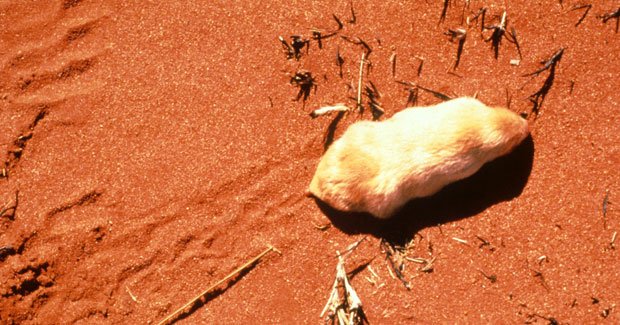The marsupial mole: an enduring enigma

UNDERGROUND IS A GOOD place to be if you live in arid sandy deserts of Central Australia.
Whereas the surface is dry and temperatures fluctuate wildly – baking on summer days and freezing on winter nights – underground the climate is much less extreme. Most small- to medium-sized animals in the desert spend at least some time sheltering underground, but marsupial moles that have taken this behaviour to the extreme and appear able to live their entire lives underground; they are arguably the world’s most burrow-adapted mammal.
Unlike most burrowing mammals, marsupial moles don’t construct hollow tunnels in which to live and run about. Instead, they tunnel and backfill as they go, carving a hole in the lightly cemented sand ahead with their extraordinary spade-like fore-feet, and pushing the loosened sand back behind themselves with their slightly webbed hind-feet. At the same time they squeeze their tubular body forward a few centimetres at a time.
They are completely blind, and use their calloused nose and forehead as a ram. They have strikingly well-developed shoulders, and their creamy-white fur is fine and silky and must pose little resistance to tunnelling.
At only 40-60 g, marsupial moles have such modest oxygen requirements that they subsist by breathing the air that flows between sand grains. While their unusual form of locomotion is slow and laborious, they also seem tuned to a frugal life and save energy and resources by allowing their body temperature to reflect that of the surrounding sand, as if they were reptiles.
MARSUPIAL MOLES ARE FOUND in the dune deserts which cover much of arid Australia. The two recognised species are similar in most respects. They are often featured in Aboriginal mythology and the names assigned to them by Indigenous custodians of the land – kakarratul (Notoryctes caurinus) found in north-west WA, and itjaritjari (Notoryctes typhlops), found in Central Australia – bear a more poetic tone than the respective northern- and southern marsupial mole labels employed by scientists.
Marsupial moles are very unlike other marsupials and some evidence suggests they branched off from the marsupial family tree 64 million years ago, not long after dinosaurs became extinct. Since then, they have undergone radical changes, although they still conform to the basic marsupial plan.
In a striking example of convergent evolution, marsupial moles have developed similar appearance and adaptations to some placental moles, particularly the Namib golden mole of Africa, which also inhabits desert dune fields. The Namib golden mole is adept at ‘swimming’ through loose sand, but routinely runs about on the surface to forage. In contrast, marsupial moles seem to flounder in loose sand, which is relatively rare in Australian deserts, and struggle to drag themselves along the surface.
Marsupial moles are at home underground where they feed on small animals such as insects, and seem especially partial to eggs, larvae and pupae. In captivity, they have also been observed to devour centipedes, spiders and geckoes and may eat similarly sized animals in the wild if given the opportunity; their ability to tunnel rapidly may make them a formidable threat to any small animal that is slow moving or dormant.
Read more info: “Searching for the marsupial mole”
ALTHOUGH MARSUPIAL MOLES HAVE been known to science for over a century, we are just beginning to learn about these strange, enigmatic little creatures. Until recently, they were only known from the very occasional finds on the surface. Many were collected by Aborigines in the early 1900s when museums paid handsomely for these difficult-to-procure animals.
Since then, specimens and sightings have averaged 5-10 per decade, suggesting that the species are either very rare or very elusive. Their remains are often found in the scats of introduced foxes, and to lesser extent introduced cats, at frequencies that are alarming in comparison to the rarity of sightings.
More recently, survey and monitoring techniques have been developed that are based on the abundance of sand-filled tunnels. These signs appear widespread and common and suggest that marsupial moles may be much more abundant than previously thought. There is, however, still uncertainty about how long they may persist in the sand and it is possible that the tunnels may reflect abundances from several decades ago.
Nonetheless, averages of 20-60 km of recognisable tunnel per hectare are common in central dunefields. Rather than being a rare curiosity, it is possible that marsupial moles might be so abundant that they profoundly affect their environment both by their consumption of prey and by turning the soil as they tunnel.
Both species are officially regarded as endangered, and are likely to remain so until further studies clarify the significance of their seemingly abundant underground signs. Threats may include introduced predators and changed fire regimes. While unsatisfying, it seems strangely fitting that these wonderfully bizarre animals should have us still confused about their abundance and conservation status.
Joe Benshemesh is a researcher in the School of Biological Sciences at La Trobe University in Melbourne. This article is an edited extract from the book A Fragile Balance: The Extraordinary Story of Australian Marsupials, edited by Chris Dickman.

